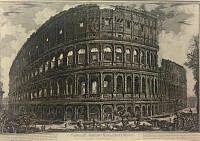BIOGRAPHY

Giovanni Battista Piranesi, Italian (1720-1778)
He was a major Italian printmaker, architect and antiquarian. The son of a Venetian master builder, he studied architecture and stage design, through which he became familiar with Illusionism*.
During a visit (1740) to Rome, which was then emerging as the center of European Neoclassicism*, Piranesi began his lifelong obsession with the visual diversity of the city's architecture.
He was taught (1740-44) etching*, the art form for which he remains best known, by Giuseppe Vasi. Piranesi then began to etch views of Roman architecture that reflected his deeply felt emotional response to the surviving remnants of ancient grandeur.
Piranesi's etchings, executed from the 1740s onward, are technically masterful evocations of ancient buildings that are simultaneously scholarly inquiries and fanciful essays in space, light, and scale. When collected and published (1756) in Antichita Romane (Roman Antiquities) the 135 etchings created a sensation throughout Europe. Equally stimulating are the superb architectural fantasies depicted in his Carceri d'Invenzione (Imaginary Prisons, begun c.1745, reworked 1761).
